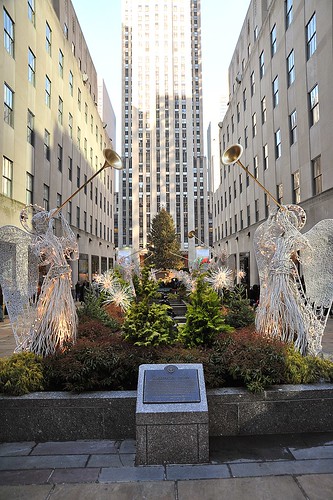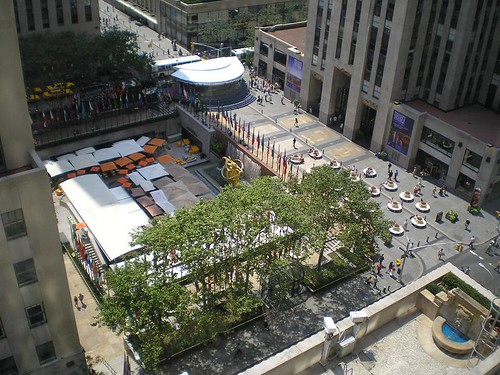How do buildings and spaces relate in an urban environment? What constitutes a vibrant urban experience? This project will take a look at the relationship between buildings and urban space.
The urban environment is constituted by buildings and the spaces between them such as streets, parks, plazas, and squares. Typically in New York, buildings are designed and built to align with the street and have no direct relationship with adjacent buildings. However, there are cases where buildings and their surrounding streets and public spaces are designed as a group. One notable example is Rockefeller Center where a group of skyscrapers share a similar architectural expression and are grouped around a central plaza that can be approached by a promenade.



For this assignment, students will work in teams of 4 (or 3) and prepare a power point presentation and a collaborative research paper on your assigned place. Each of you will take one of the topics below, go to your place and photograph things that relate to your topic. I would recommend that you go together so you can discuss what you are documenting and share your observations.
Places from which to choose:
1. World Trade Center
2. Lincoln Center
3. Columbia University
4. Brooklyn College
5. Times Square
6. NYU
7. City College
The topics are as follows:
1. TOPIC 1. Describe the buildings:
a. What do they look like?
b. What are they made of?
c. Do they work together (scale, material, color)
2. TOPIC 2. Describe how the building masses relate to the public spaces
a. What is dominant, the building(s) or the space?
b. Is there a hierarchy among the building?
c. Is there a center of the complex?
3. TOPIC 3. Describe how the public spaces are treated:
a. Are they landscaped
b. Are there places for people to meet and sit?
c. What are the people around there doing?
4. TOPIC 4. How is the infrastructure treated?
a. Where do the cars go?
b. Are the pedestrians separated from the cars?
c. Where do the loading trucks go?
PART 1: Background research on your topic
(English 1101) You will conduct research collaboratively in your group to explore the history of the place you have chosen/been assigned. As a group, you will find at least five sources, including at least one peer-reviewed scholarly article or a university press book, one article from a reputable news source, and one interview, oral history or archival source.
PART 2: An evaluation of your topic
Each of you separately will write a one page (250-word) essay that critically evaluates your place. What works and what doesn’t? Is the place a nice place to be: if it is, why; if it is not, why not? What is the best thing about it; the worst? Be specific: if you like something, give us a reason; if it’s nice, tell us why. Cite the things you observe as evidence: “The street felt very welcoming to pedestrians; the buildings on either side were a nice scale at three stories, and proportionally related to each other. The car traffic was slow enough to allow pedestrians to cross from one side to other comfortably.” THIS WILL BE TURNED IN NEXT CLASS SEPARATELY FROM YOUR PRESENTATION.
PART 3: Power point presentation
Your presentation should have:
1. A site plan showing all the buildings, spaces, streets, etc.
2. 10 to 15 slides covering your topic. If you are showing a street, you should have a site plan showing where that street is. Similarly, if you are showing a building, you should show us on a site plan where that building is.
3. An evaluation of your topic taken from your essays (see below) in the form of bullet points.
First you must do some background research on your place. You should always begin a project knowing as much as you can about your site. After you have visited the site and recorded your observations you will bring you findings to next class (Nov. 17) and you will work with your team members to assemble your presentation. I will reserve computers where you can work during class. Whatever you don’t finish in the lab you will have to finish on your own.
I am inviting another professor to view your presentations and to give you input on your content and delivery.
Part 4: Collaborative Research Paper (Learning Community only)
Based on your research and presentation, you will collaboratively write a 5-7 page research paper about your topic. It will include a clear thesis statement. You must include at least 5 sources. These should include previous research to explore the history of the place, the demographics of the neighborhood, and social or economic questions, concerns or conflicts related to this public space. Your sources should include: at least one peer-reviewed source, at least one article from a reputable news source, and at least one source that is either an interview, an oral history or an archival source. As a group, you should also think about stylistic choices you want to make, and incorporate techniques you have noticed in the work of at least one writer you have read over the course of the semester. You will submit an abstract and an annotated bibliography at least two weeks prior to the due date. This will be evaluated as part of your final grade for the project.



